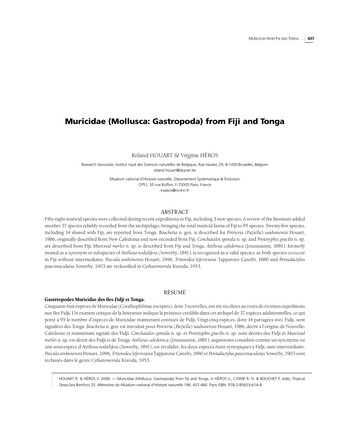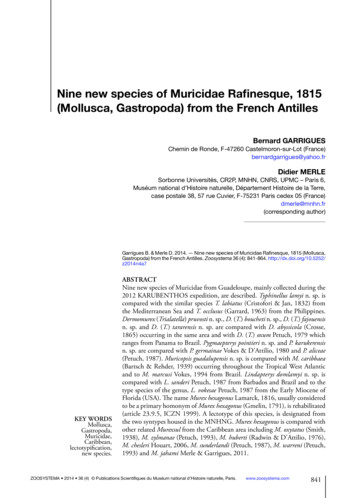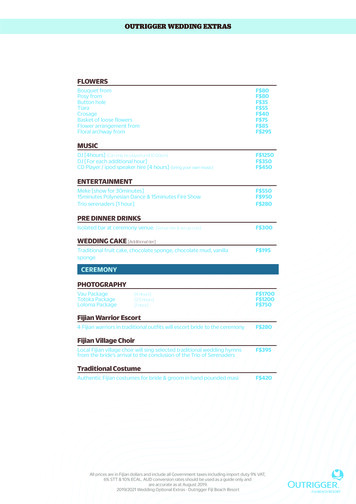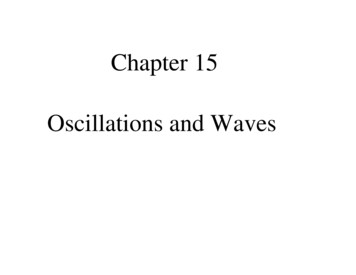
Transcription
MURICIDAE FROM FIJI AND TONGAMuricidae (Mollusca: Gastropoda) from Fiji and TongaRoland HOUART & Virginie HÉROSResearch Associate, Institut royal des Sciences naturelles de Belgique, Rue Vautier, 29, B-1000 Bruxelles, Belgiumroland.houart@skynet.beMuséum national d’Histoire naturelle, Département Systématique & ÉvolutionCP51, 55 rue Buffon, F-75005 Paris, Francemalaco@mnhn.frABSTRACTFifty-eight muricid species were collected during recent expeditions to Fiji, including 3 new species. A review of the literature addedanother 37 species reliably recorded from the archipelago, bringing the total muricid fauna of Fiji to 95 species. Twenty-five species,including 14 shared with Fiji, are reported from Tonga. Bouchetia n. gen. is described for Poirieria (Paziella) vaubanensis Houart,1986, originally described from New Caledonia and now recorded from Fiji. Conchatalos spinula n. sp. and Prototyphis gracilis n. sp.are described from Fiji; Murexsul merlei n. sp. is described from Fiji and Tonga. Attiliosa caledonica (Jousseaume, 1881), formerlytreated as a synonym or subspecies of Attiliosa nodulifera (Sowerby, 1841), is recognized as a valid species, as both species co-occurin Fiji without intermediates. Pascula ambonensis Houart, 1996, Tritonidea lefevreiana Tapparone Canefri, 1880 and Pentadactyluspaucimaculatus Sowerby, 1903 are reclassified in Cytharomorula Kuroda, 1953.RÉSUMÉGastéropodes Muricidae des îles Fidji et Tonga.Cinquante-huit espèces de Muricidae (Coralliophilinae exceptés), dont 3 nouvelles, ont été récoltées au cours de récentes expéditionsaux îles Fidji. Un examen critique de la littérature indique la présence crédible dans cet archipel de 37 espèces additionnelles, ce quiporte à 95 le nombre d’espèces de Muricidae maintenant connues de Fidji. Vingt-cinq espèces, dont 14 partagées avec Fidji, sontsignalées des Tonga. Bouchetia n. gen. est introduit pour Poirieria (Paziella) vaubanensis Houart, 1986, décrit à l’origine de NouvelleCalédonie et maintenant signalé des Fidji. Conchatalos spinula n. sp. et Prototyphis gracilis n. sp. sont décrits des Fidji et Murexsulmerlei n. sp. est décrit des Fidji et de Tonga. Attiliosa caledonica (Jousseaume, 1881), auparavant considéré comme un synonyme ouune sous-espèce d’Attiliosa nodulifera (Sowerby, 1841), est revalidée, les deux espèces étant syntopiques à Fidji, sans intermédiaire.Pascula ambonensis Houart, 1996, Tritonidea lefevreiana Tapparone Canefri, 1880 et Pentadactylus paucimaculatus Sowerby, 1903 sontreclassés dans le genre Cytharomorula Kuroda, 1953.HOUART R. & HÉROS V. 2008. — Muricidae (Mollusca: Gastropoda) from Fiji and Tonga, in HÉROS V., COWIE R. H. & BOUCHET P. (eds), TropicalDeep-Sea Benthos 25. Mémoires du Muséum national d’Histoire naturelle 196: 437-480. Paris ISBN: 978-2-85653-614-8.437
438ROLAND HOUART & VIRGINIE HÉROSINTRODUCTIONThis paper is a continuation of the senior author’s ongoing reports on the Muricidae (Coralliophilinae excepted;for the latter, see Oliverio, this volume) sampled during the exploring expeditions of the Muséum national d’HistoireNaturelle (MNHN) and the Institut de Recherche pour le Développement (IRD, Nouméa) to the tropical South andWest Pacific. The present report focusses on the island groups of Fiji and Tonga, which were specifically exploredin 1998-2000 during the MUSORSTOM 10 and BORDAU 1 cruises to Fiji and BORDAU 2 cruise to Tonga (for thecontext and narratives of these expeditions, see the introductory chapter by Bouchet et al., this volume), with theadjunction of scattered samples taken during an ecological survey of southern Viti Levu (SUVA 2 and SUVA 4 cruises).Prior to these expeditions, the muricid fauna of Fiji had been the focus of two papers by Cernohorsky (1967, 1969).Walter Cernohorsky, at that time a resident of Viti Levu, collected intertidally or in the shallow subtidal, and hispapers thus contain many Fiji records with little or no overlap with the MUSORSTOM and BORDAU expeditions,which conversely focussed on the deep offshore (100-1200 m). Cernohorsky’s records were fully illustrated, whichallows for corrections of taxonomy and changes of nomenclature that have taken place in the intervening 40 years.Updated Cernohorsky records and the present new data together account for 95 muricid species now recorded fromFiji (Table 2).Tonga was much less intensively surveyed. Historically, Tonga was collected by Eduard Graeffe, a young naturalistsent by the Hamburg-based trading company of Cesar Godeffroy to explore Samoa, Uvea [ Wallis], Tonga andFiji; in Tonga, Graeffe visited Niuafou, the Vavau and Ha‘apai groups, and Tongatabu. Undoubtedly, a numberof records of marine species from Tonga in, e.g., Paetel’s catalogue (Paetel 1888), must originate from Graeffe.Graeffe’s muricid records from Tonga may be scattered in other late 19th century literature and were unillustrated;also, the Godeffroy Museum, later incorporated in the Hamburg University Museum, was destroyed during thebombing of Hamburg at the end of World War II. All this makes the historical muricid records from Tonga outdatedand essentially unverifiable. Consequently, although the 25 muricid species sampled by the French BORDAU 2expedition (Table 3) undoubtedly represent only a fraction of the local fauna (especially, all the intertidal andshallow subtidal taxa are missing), no attempt has been made to reconcile the historical records with modernsystematics and nomenclature.In the present report, the references for each species are restricted to the original description and, if any, references to their occurrence in Fiji and Tonga. The spiral cord and apertural denticle terminology is mainly based onMerle (1999, 2001; here Table 1). Under “Distribution” the bathymetric distribution summarizes the local recordsfrom Fiji and Tonga only.RepositoriesIRD: Institut de Recherche pour le Développement (formerly ORSTOM)MNHN: Muséum national d’Histoire naturelle, ParisNMNZ: Museum of New Zealand Te Papa Tongarewa, WellingtonSMNH: Swedish Museum of Natural History, Stockholm.Abbreviationsdd: dead specimen(s)juv: juvenile specimen(s)lv: live specimen(s).
MURICIDAE FROM FIJI AND TONGATABLE 1. — Terminology used to describe the spiral cords and the internal denticles of the outer lip (based on Merle 1999, PEABIDD1-D5Primary cordSecondary cordTertiary cordAdapicalAbapicalSubsutural cord (adapical to IP)Infrasutural primary cord (primary cord on shoulder)Adapical infrasutural secondary cord (shoulder)Abapical infrasutural secondary cord (shoulder)Shoulder cordPrimary cords of the convex part of the teleoconch whorl or of the siphonal canalSecondary cordsSecondary cord between P1 and P2; s2: secondary cord between P2 and P3Tertiary cord between P1 and s1Tertiary cord between s1 and P2Adapical siphonal cordMedian siphonal cordAbapical siphonal cordExtreme abapical cordInfrasutural denticle of the apertureDenticles of the convex part of the apertureSYSTEMATIC ACCOUNTFamily MURICIDAE Rafinesque, 1815Subfamily MURICINAE Rafinesque, 1815Genus MUREX Linné, 1758Murex aduncospinosus (Sowerby, 1841)Fig. 1AMurex ternispina var. aduncospinosus Sowerby, 1841: 1, pl. 188, fig. 68.Other references:Murex trapa - Cernorhorsky 1967: 115 (in part), pl. 14, fig. 1 (non Murex trapa Röding, 1798).Murex aduncospinosus - Ponder & Vokes 1988: 34, fig. 81-F.MATERIAL EXAMINED. — Fiji. MUSORSTOM 10: stn DW1362, 18 12’S, 178 36’E, 80-89 m, 3 lv, 2 dd juv; stn CP 1366,18 12’S, 178 33’E, 149-168 m, 1 dd juv. — SUVA 2: stn CP23, 18 11’S, 178 34’E, 26 m, 1 lv, 2 dd; stn CP 24, 18 11’S,178 34’E, 26 m, 1 lv; stn BS 34, 18 08’S, 178 25’S, 20 m, 1 lvjuv; stn CP 47, 17 54’S, 177 14’E, 25 m, 22 lv many juv (Fig. 1A)& dd many juv; stn BS 49, 17 45’S, 177 12’E, 23 m, 6 lv; stnCP 80, 17 38’S, 177 20’E, 36 m, 1 lv, 1 dd; stn CP 84, 17 40’S,177 22’E, 22 m, 1 lv. — SUVA 4: stn BS 29, 18 17’S, 178 05’E,35 m, 1 lv juv; stn CP 30, 18 17’S, 178 04’E, 32 m, 2 dd.439
440ROLAND HOUART & VIRGINIE HÉROSDISTRIBUTION. — Central Indo-West Pacific: Japan, Taiwan, the Philippines, Indonesia and Fiji, live in 22-80 m,shells to 168 m.REMARKS. — Ponder & Vokes (1988: 34) commented on the various forms of M. aduncospinosus and illustrated abeautiful specimen from Fiji (fig. 81F). In the Fiji form, the space between the spiral cords is coloured dark brown.Otherwise the protoconch, teleoconch sculpture and organization of the spines are identical to the typical form, fromIndonesia.Murex tenuirostrum Lamarck, 1822Fig. 1BMurex tenuirostrum Lamarck, 1822: 159.Other reference:Murex tribulus - Cernohorsky 1967: 115 (in part), pl. 14, fig. 2.MATERIAL EXAMINED. — Fiji. MUSORSTOM 10: stn DW 1333,16 50’S, 178 13’E, 200-215 m, 1 dd juv; stn CP 1371, 18 12’S,178 33’E, 135-151 m, 1 lv juv. — SUVA 2: stn DW 44, 17 52’S,177 13’E, 33 m, 4 dd; stn CP 45, 17 52’S, 177 13’E, 35 m, 2lv, 1 dd; stn CP 48, 17 56’S, 177 14’E, 16 m, 2 lv; stn BS 49,17 45’S, 177 12’E, 23 m, 1 lv; stn DW 50, 17 45’S, 177 14’E,36 m, 1dd; stn CP 57, 17 43’S, 177 23’E, 17 m, 2 lv; stn CP 65,17 48’S, 177 13’E, 32 m, 1 lv juv; stn CP 66, 17 45’S, 177 14’E,37 m, 1 lv (Fig. 1B); stn CP 67, 17 44’S, 177 18’E, 28 m, 1 lv. —BORDAU 1: stn DW 1498, 18 41’S, 178 28’W, 300-307 m, 1 ddjuv. — SUVA 4: stn DW 09, 18 21’S, 178 06’E, 37-41 m, 1 lv; stnDW 16, 18 26’S, 178 07’E, 32-36 m, 1 lv; stn CP 18, 18 26’S,178 06’E, 44-45 m, 4 lv; stn CP 19, 18 26’S, 178 04’E, 48-50 m,7 lv & dd; stn CP 20, 18 26’S, 178 02’E, 50-51 m, 17 lv & dd;stn CP 30, 18 17’S, 178 04’E, 32 m, 6 lv & dd.Tonga. BORDAU 2: stn CP 1582, 18 41’S, 174 03’W, 79-82 m,1 lv (juv.), 1 dd.DISTRIBUTION. — Indo-West Pacific, Fiji and Tonga, live in 16-135 m, shells to 307 m.REMARKS. — Murex tenuirostrum is probably the most common species in the genus. It has been wrongly identified asM. tribulus Linné, 1758 in many publications but differs from M. tribulus in having a more nodose (cancellate) sculpture, fewer spines on the siphonal canal, and more rounded and nodose first teleoconch whorls (Ponder & Vokes1988: 24). Both species have a conical multispiral protoconch, indicating planktotrophic larval development.Murex troscheli Lischke, 1868Fig. 1CMurex troscheli Lischke, 1868: 219; 1869: 41, pl. 1, figs 1-2.MATERIAL EXAMINED. — Fiji. MUSORSTOM 10: stn CP 1328, 17 17’S, 177 50’E, 248-277 m, 2 lv (Fig. 1C); stn DW 1384,18 19’S, 178 06’E, 260-305 m, 1 dd juv; stn CP 1387, 18 19’S, 178 05’E, 229-370 m, 1 lv; stn CP 1389, 18 19’S, 178 05’E, 241417 m, 1 dd.DISTRIBUTION. — Central Indo-West Pacific: from southern Japan, Taiwan, the Philippines, Indonesia, the SolomonIslands and Fiji (new record), live in 248-277 m. Also from off Port Hedland, Western Australia.
MURICIDAE FROM FIJI AND TONGAREMARKS. — At first sight, the Fiji specimens seem to differ from typical M. troscheli (in their heavier varices, narrower axial ribs, and absence of brown colouration at the top of the spiral cords); however, a careful study of theprotoconch, spiral and axial sculpture of the teleoconch whorls, and organization of the spines leaves no doubt abouttheir correct identification. The shells from Fiji are uniformly whitish, smaller and more slender than the typical form.They could be considered as intermediate between the typical form, from the Philippines, and the form named M.heros Fulton, 1936 from the Solomon Islands.Genus VOKESIMUREX Petuch, 1994Vokesimurex dentifer coriolis (Houart, 1990)Haustellum dentifer coriolis Houart, 1990: 335, figs 8-10, 27.MATERIAL EXAMINED. — Fiji. MUSORSTOM 10: stn DW 1333, 16 50’S, 178 13’E, 200-215 m, 1 dd juv; stn DW 1334, 16 51’S,178 14’E, 251-257 m, 1 dd juv.DISTRIBUTION. — New Caledonia and Fiji (new record), shells in 215-251 m. The nominotypical subspecies Vosekimurex dentifer dentifer (Watson, 1883) is known from the Moluccas, Borneo, the Philippines, Taiwan and southernJapan.REMARKS. — Although only two juvenile specimens were collected, it was possible to identify them without anydoubt from the characters of the protoconch and the first teleoconch whorls. The protoconch consists of two glossy,rounded whorls and the shell begins to develop axial varices on the third or fourth teleoconch whorl, having 9-11axial ribs on previous whorls.Vokesimurex dolichourus (Ponder & Vokes, 1988)Haustellum dolichourus Ponder & Vokes, 1988: 105, figs 50 L-N, 68 H, 79 A, 88 F.MATERIAL EXAMINED. — Fiji. MUSORSTOM 10: stn CP 1349, 17 31’S, 178 39’E, 244-252 m, 1 dd juv; stn CP 1387, 18 19’S,178 05’E, 229-370 m, 1 lv juv; stn CP 1390, 18 19’S, 178 05’E, 234-361 m, 1 dd juv.DISTRIBUTION. — Indo-West Pacific: from Madagascar to Taiwan, Papua New Guinea, Australia (Queensland) andnow Fiji (new record), shells in 244-252 m, live in 229-370 m; Pleistocene of Vanuatu (Ponder & Vokes 1988: 106).REMARKS. — Vokesimurex dolichourus resembles V. kiiensis (Kira, 1959) (see below), but the protoconch of V. dolichourus is broader with a broader first whorl and fewer (2-2.5 vs. 3-3.5) more rounded whorls. The shell is heavierwith a comparatively smaller aperture, higher spire and broader varices.Vokesimurex hirasei (Hirase, 1915)Fig. 1DMurex hirasei Hirase, 1915: pl. 47, fig. 232.441
442ROLAND HOUART & VIRGINIE HÉROSMATERIAL EXAMINED. — Fiji. MUSORSTOM 10: stn CP1387, 18 19’S, 178 05’E, 229-370 m, 1 dd. — BORDAU 1: stnDW 1464, 18 09’S, 178 38’W, 285-300 m, 2 dd juv; stn DW1469, 19 40’S, 178 10’W, 314-377 m, 1 lv, 1 dd; stn DW 1470,19 40’S, 178 10’W, 316-323 m, 1 dd; stn DW 1471, 19 40’S,178 10’W, 280-296 m, 1 lv; stn DW 1472, 19 40’S, 178 10’W,262-266 m, 1 lv; stn DW 1475, 19 41’S, 178 11’W, 321-424 m,4 lv (Fig. 1D); stn CP 1476, 19 41’S, 178 11’W, 310-420 m, 1 lvjuv; stn DW 1497, 18 44’S, 178 25’W, 335-350 m, 4 lv & dd.Tonga. BORDAU 2: stn DW 1535, 21 43’S, 175 18’W, 268 m,1 lv juv; stn DW 1540, 21 15’S, 175 14’W, 317-329 m, 1 dd juv;stn CP 1541, 21 15’S, 175 14’W, 319-333 m, 1 lv juv; stn DW1586, 18 34’S, 173 55’W, 440-487 m, 1 dd juv; stn DW 1602,20 49’S, 174 57’W, 263-320 m, 2 dd; stn DW 1603, 22 12’S,175 20’W, 189-196 m, 1 dd; stn DW 1607, 22 15’S, 175 23’W,356-367 m, 1 dd; stn DW 1610, 22 59’S, 175 47’W, 216-237 m,1 lv; stn DW 1611, 23 00’S, 175 47’W, 278-323 m, 1 dd juv. stnDW 1636, 21 44’S, 175 20’W, 321-331 m, 1 dd.DISTRIBUTION. —Known from Japan, New Caledonia, Vanuatu, and now Fiji and Tonga (new records), live in 237335 m.REMARKS. — Vokesimurex hirasei is easily distinguishable from its congeners by its multispiral, conical protoconchand rounded, broad last teleoconch whorl with some dark brown spiral cords.Vokesimurex kiiensis (Kira, 1959)Fig. 1HMurex kiiensis Kira, 1959: 58, pl. 23, fig. 10.MATERIAL EXAMINED. — Fiji. BORDAU 1: stn DW 1494, 18 55’S, 178 29’W, 240-319 m, 1 lv, 1 dd.DISTRIBUTION. — Japan, the Philippines and now Fiji (new record), live in 240-319 m.REMARKS. — Vokesimurex kiiensis has a conical, multispiral protoconch, short, blunt, shoulder spines, and crowded,short, blunt spines (ADP, MP, ABP and occasionally EAB1; see Table 1 for explanation of terms) at the base of thesiphonal canal.Vokesimurex mindanaoensis (Sowerby, 1841)Fig. 1GMurex mindinaoensis (sic) Sowerby, 1841: 2, pl. 194, fig. 92.Murex mindanaoensis - Vokes, 1971: 70 (justified emendation).MATERIAL EXAMINED. — Fiji. MUSORSTOM 10: stn CP 1323,17 16’S, 177 46’E, 143-173 m, 1 lv; stn CP 1363, 18 12’S,178 33’E, 144-150 m, 2 lv, 1 dd; stn CP 1366, 18 12’S, 178 33’E,149-168 m, 5 lv, 2 dd; stn DW 1370, 18 12’S, 178 33’E, 113123 m, 1 lv (Fig. 1G); stn CP 1371, 18 12’S, 178 33’E, 135-151m, 1 lv; stn CP 1390, 18 19’S, 178 05’E, 234-361 m, 2 dd. —BORDAU 1: stn CP 1402, 16 38’S, 179 36’E, 260-279 m, 1 lv;stn CP 1403, 16 40’S, 179 36’E, 220-224 m, 1 dd; stn CP 1404,16 40’S, 179 36’E, 180 m, 2 dd.DISTRIBUTION. — The Philippines, Papua New Guinea (Ponder & Vokes 1988: 115) and now Fiji (new record), livein 123-260 m.
MURICIDAE FROM FIJI AND TONGAREMARKS. — All the shells examined from Fiji are similar to Philippines specimens. Vokesimurex mindanaoensis isdistinguishable by its high spire with short shoulder spines, its numerous short spines on the broad, rounded varicesof the last whorl, and its almost spineless, long siphonal canal.Vokesimurex sp. cf. hirasei (Hirase, 1915)Fig. 1EMATERIAL EXAMINED. — Tonga. BORDAU 2: stn DW 1603, 22 12’S, 175 20’W, 189-196 m, 1 dd.REMARKS. —This specimen is referred with doubt to Vokesimurex hirasei from which it differs in having a slightly broader last teleoconch whorl and in lacking the typical creamish-white colour with dark brown spiral cords. Vokesimurex sp.cf. hirasei has a pale tan shell with bands of a slightly darker color at the shoulder and periphery. The protoconch is incomplete with only the last whorl remaining. A typical, living specimen of V. hirasei was collected at the same station.Genus CHICOREUS Montfort, 1810Subgenus TRIPLEX Perry, 1811Chicoreus (Triplex) boucheti Houart, 1983Chicoreus boucheti Houart, 1983: 27, text figs 3-4, pl. 1, figs 1-2.MATERIAL EXAMINED. — Fiji. SUVA 2: stn BS 10, 18 12’S, 178 30’E, 123 m, 1 dd juv (damaged).Tonga. BORDAU 2: stn DW 1567, 21 02’S, 175 19’W, 351-356 m, 1 dd juv (damaged).DISTRIBUTION. — New Caledonia, now Fiji and Tonga (new records), shells only in 123-351 m.REMARKS. — Chicoreus boucheti has a typical broad and large protoconch consisting of 1¼ to 1½ whorls, and long,open spines in the extension of P1, P3 and P5.Chicoreus (Triplex) nobilis Shikama, 1977Fig. 1IChicoreus (Triplex) nobilis Shikama, 1977: 14, pl. 2, fig. 9, pl. 5, fig. 1.Other references:Chicoreus aculeatus - Cernohorsky 1967: 117, pl. 14, fig. 5, text fig. 1 (non M. aculeatus Lamarck, 1822).Chicoreus (Triplex) nobilis - Houart 1992: 100, figs 55, 110-111, 137, 202, 208-210, 211, 251.MATERIAL EXAMINED. — Fiji. SUVA 2: stn DW 62, 17 48’S, 177 13’E, 32 m, 1 dd. — SUVA 4: stn DW08, 18 22’S, 178 02’E, 2830 m, 8 lv & dd juv; stn DW 22, 18 27’S, 177 59’E, 32-36 m, 1 lv juv; stn DW 26, 18 24’S, 178 05’E, 42-43 m, 1 dd (Fig. 1I).DISTRIBUTION. — Western Pacific: Taiwan, the Philippines, Papua New Guinea, the Coral Sea, New Caledonia andFiji, live in 28-32 m, shells in 30-42 m.443
444ROLAND HOUART & VIRGINIE HÉROSABDCEIFGH
MURICIDAE FROM FIJI AND TONGAREMARKS. — The Fiji specimens have spineless teleoconch whorls although other shell characters are identical tothe typical form of Chicoreus nobilis. A specimen from Fiji was illustrated previously by Houart (1992: 101, fig. 210).Chicoreus nobilis is included in a group of small species (20-53 mm) with short varical, frondose spines. It differsfrom the other species in having 2 or 3 frondose, adaperturally recurved spines on the abapical end of the siphonalcanal.Chicoreus (Triplex) ryukyuensis Shikama, 1978Fig. 1FChicoreus (Triplex) ryukyuensis Shikama, 1978: 35, pl. 7, figs 1-2.MATERIAL EXAMINED. — Tonga. BORDAU 2: stn CP 1582, 18 41’S, 174 03’W, 79-82 m, 2 lv.DISTRIBUTION. — Okinawa, Guam (R. Houart coll., unpublished) and now Tonga (new record), live in 79-82 m.REMARKS. — Chicoreus ryukyuensis is included in the same group of small species as C. nobilis. It differs from C.nobilis in having a globose rather than conical protoconch and 3 frondose spines covering the entire length of thesiphonal canal.Subgenus CHICOPINNATUS Houart, 1992Chicoreus (Chicopinnatus) orchidiflorus (Shikama, 1973)Pterynotus orchidiflorus Shikama, 1973: 5, pl. 2, figs 7-8.MATERIAL EXAMINED. — Fiji. MUSORSTOM 10: stn DW 1333, 16 50’S, 178 13’E, 200-215 m, 1 dd (damaged); stn DW 1384,18 19’S, 178 06’E, 260-305 m, 1 dd.DISTRIBUTION. — Indo-West Pacific: Reunion, Mauritius, Taiwan, the Philippines, New Caledonia, Fiji (new record),shells in 215-260 m, and Tubuaï.REMARKS. — The shell of C. orchidiflorus bears 3 finely folded, wing-like varices, with adapical and abapical parts ofthe wings either separate or joined by a thin webbing.Subgenus SIRATUS Jousseaume, 1880FIG. 1. A, Murex aduncospinosus (Sowerby, 1841), Fiji, SUVA 2 CP 47, h 75.4 mm. B, Murex tenuirostrum Lamarck, 1822, Fiji, SUVA 2 CP 66, h 94.2 mm.C, Murex troscheli Lischke, 1868, Fiji, MUSORSTOM
s1-s6 Secondary cords . Genus MUREX Linné, 1758 Murex aduncospinosus . shells to 307 m. REMARKS. — Murex tenuirostr











